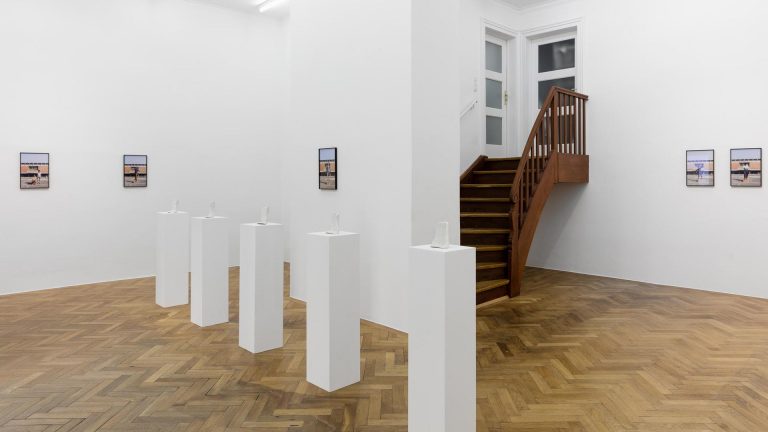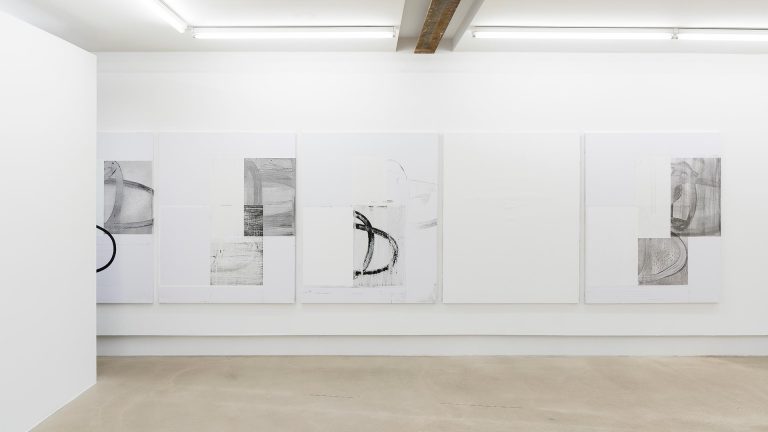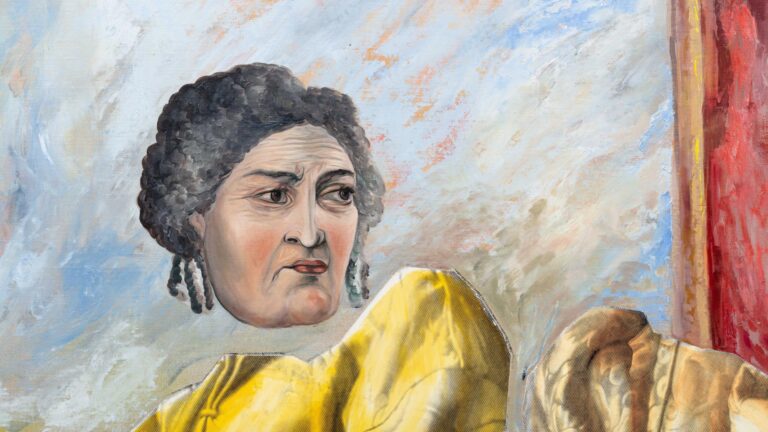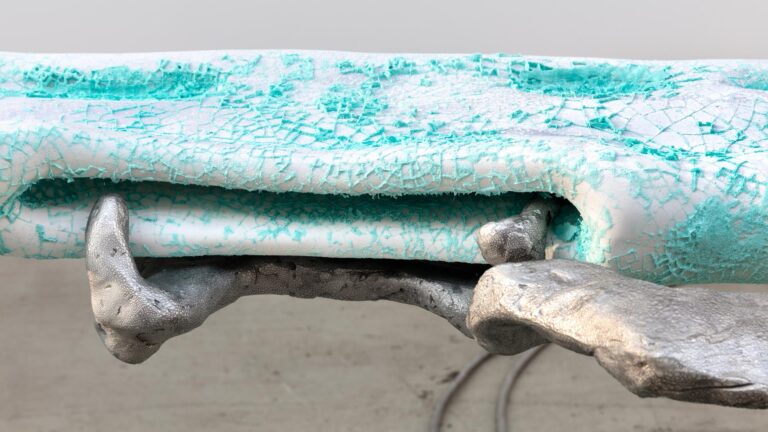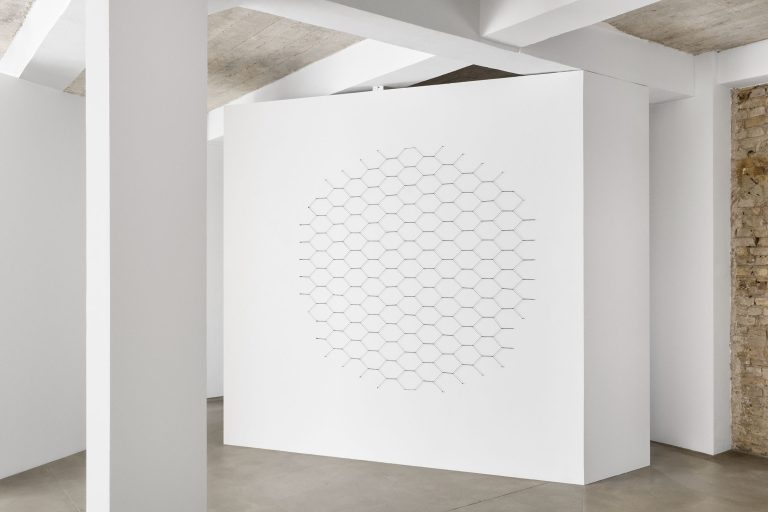Artists: Carl Andre, Richard Artschwager, Jo Baer, Bernd und Hilla Becher, Michael Beutler, Benedikte Bjerre, Alighiero Boetti, Bill Bollinger, George Brecht, Marcel Broodthaers, Walter De Maria, Dan Flavin, Ceal Floyer, William Forsythe, Günther Förg, Isa Genzken, Hermann Goepfert, Bethan Huws, Donald Judd, On Kawara, Ellsworth Kelly, Joseph Kosuth, Gary Kuehn, Barry La Va, Robert Mangold, Teresa Margolles, Sarah Morris, Bruce Nauman, Kenneth C. Noland, Blinky Palermo, Steven Parrino, Angelika Platen, Charlotte Posenenske, Timm Rautert, Peter Roehr, Reiner Ruthenbeck, Ulrich Rückriem, Robert Ryman, Fred Sandback, Richard Serra, Paul Sharits, Santiago Sierra, Andreas Slominski, Lewis Stein, Heide Stolz, Franz Erhard Walther, Jonas Weichsel, Lawrence Weiner
Exhibition title: Primary Structures. Masterworks of Minimal Art
Curated by: Mario Kramer
Venue: MMK Frankfurt am Main, Frankfurt am Main, Germany
Date: February 22 – August 13, 2017
Photography: all images copyright and courtesy of the artists and MMK Frankfurt am Main
Among the holdings of the MMK Museum für Moderne Kunst Frankfurt am Main is an important collection of outstanding works of minimal art of the 1960s and ’70s. In a major survey featuring nearly fifty artists, the MMK is now presenting the masterworks of this collection comprehensively for the first time.
The unique group of works by American minimalists of the early 1960s made its way into the museum when the city of Frankfurt purchased the former Karl Ströher collection in 1981. An acquisition of 2006, now of the works amassed by the former gallery owner and collector Rolf Ricke, further enhanced the MMK holdings with outstanding examples of post-minimalism.
“It has long been our wish to present the highlights of this important MMK focus on a comprehensive scale. The exhibition will once again testify to the tremendous quality of the MMK collection and the treasures that lie concealed here, but also to the influence of the early minimalists on artists of subsequent generations and up to the present”, remarks MMK director Prof Susanne Gaensheimer.
Seriality, conceptuality and industrial production were the new principles pursued by the minimalists Carl Andre, Walter De Maria, Dan Flavin, Donald Judd and Fred Sandback, who revolutionized art in the 1960s with their radical works. For the first time in the history of art, they used industrially manufactured or processed materials and reduced their works to basic geometric structures they termed “primary structures”. With this title, the presentation at the MMK 2 also makes direct reference to the very first exhibition of minimal art – the trailblazing show of the same name staged at the Jewish Museum in New York in 1966. Walter de Maria’s key work Cage of 1965 – today in the MMK collection – was on view in that exhibition.
The MMK show will get off to a start with the reconstruction of two historical installations that – originally presented at the legendary Heiner Friedrich gallery in Munich in 1968 – mark the beginning of the reception of minimal art in Germany: Carl Andre’s floor sculpture 22 Steel Row and Dan Flavin’s light installation Two Primary Series and One Secondary. The two artists designed the works especially for the tripartite space offered by the Munich gallery. From 1968 onward, Heiner Friedrich consistently devoted his gallery work to the new artistic current, and he was the first to introduce such artists as Sol LeWitt, Carl Andre, Dan Flavin, Walter De Maria, Fred Sandback or Robert Ryman in solo exhibitions in Germany. “In retrospect, it can safely be said that 1968 was an epochal exhibition year at the Galerie Heiner Friedrich, a year that would make art history. And thanks to Karl Ströher’s numerous purchases of art by these artists at that early point in time, many of the works also went into the making of the MMK’s collection history”, points out Dr Mario Kramer, head of the MMK collection and curator of the exhibition. The dimensions and proportions of the works in the Galerie Friedrich only make sense in view of the historical spatial conditions there, which have been replicated at the MMK 2. Originally serving as a residential flat, the gallery rooms had the classical proportions of 3 x 6, 6 x 6 and 3 x 6 metres, with 3.2-metre-high ceilings. During the first half of the exhibition (22 Feb. to 14 May 2017) the MMK 2 will feature the reconstruction of Carl Andre’s floor sculpture, and in the second half (starting on 16 May 2017), that of the work by Dan Flavin.
Carl Andre’s 35 Timber Line (1968) will be on view in an MMK exhibition for the very first time. The work has belonged to the holdings since the museum’s opening in 1991, but for reasons of space has never been placed on display. After so many years in storage, the 35-metre work will now finally celebrate its MMK premiere in the spacious facilities of the MMK 2 within the context of the exhibition “Primary Structures”. The heavy wooden beams have the quality of a barrier cutting the exhibition space in two and challenging visitors to cross it. When visitors walk the length of the work, the clear subdivision into one-metre segments raise their awareness of the spatial proportions. In radically reductive manner, 35 Timber Line manifests Carl Andre’s artistic creed – to create a tension-charged relationship between a sculpture and its immediate surroundings. For the visitors, the perception of space is a very immediate experience when, by walking the length of the Line, they participate in the relationship between space and body intended by the artist.
In addition to masterworks by the most important exponents of minimalism in 1960s U.S.A. and Germany, the MMK 2 will also present examples by members of younger generations, whose installations – many quite large in scale – bear a strong relationship to the minimalist current. Among these artists are Jo Baer, Bruce Nauman, Robert Barry, Robert Mangold, Charlotte Posenenske, Peter Roehr, Lewis Stein and William Forsythe, but also and above all their successors, for example Michael Beutler, Benedikte Bjerre, Ceal Floyer, Teresa Margolles, Sarah Morris, Santiago Sierra or Jonas Weichsel.
The most recent new acquisition to be included in the show is 20 Pieces of Road Measuring 100 x 100 cm Pulled up from the Ground (1992), a key work by the Latin American concept and action artist Santiago Sierra. For its presentation here, construction workers cut 20 one-square-metre slabs of asphalt out of a Frankfurt street. The squares have been laid out in the exhibition space in grid form. Santiago Sierra conceives of the human being and the body as worker and workforce operating in social space. He demonstrates a fact-bound mode of thought that – entirely in keeping with minimalist concepts – stresses the industrial production of his installations. At the same time, however, he charges his works with sociopolitical meaning.
A further room in the exhibition makes use of the Petersburg presentation mode to explore the function of the drawing. Drawings on paper have always been the foundation of the original artistic process. They often served the minimalists as the point of departure – but also the destination – of their new strategies, which they articulated in concepts, diagrams, sketches or accompanying preliminary drawings. With only few exceptions, the drawings on display bear a direct relation to sculptural or space-specific works in the MMK collection. Their functions can be very different: the drawing as definition, as elucidation, as ritual, as investigation, even as certificate. In each case, they bear the individual thumbprint of the respective artist. The artistic media they employ are equally diverse, ranging from the classical pencil or ink on paper to such techniques as screen print, stencil, stamp or typewriting, and also encompassing digital forms of expression.
Michael Beutler’s work Outdoor-yellow 13 (2004) will conclude the show in the main lobby of the TaunusTurm. There visitors will encounter huge, bright yellow sculptures made of “Pecafil”, a material typically used in the building industry. Beutler releases it from its serviceability as a building material, however, assigning it a sculptural value of its own instead. And he has changed and expanded his work in response to the unusually high exhibition space. In view of its industrially predetermined primary colour and its materiality, Beutler’s installation likewise draws on the concepts of minimal art.
Teresa Margolles, Banco, 2004, exhibition view MMK Museum für Moderne Kunst Frankfurt am Main, photo: Axel Schneider
Dan Flavin, Two primary series and one secondary, 1968, exhibition view MMK Museum für Moderne Kunst Frankfurt am Main, Foto/photo: Axel Schneider, © Estate of Dan Flavin/ VG Bild-Kunst, Bonn 2017
Dan Flavin, Two primary series and one secondary, 1968, exhibition view MMK Museum für Moderne Kunst Frankfurt am Main, Foto/photo: Axel Schneider, © Estate of Dan Flavin/ VG Bild-Kunst, Bonn 2017
Dan Flavin, Two primary series and one secondary, 1968, exhibition view MMK Museum für Moderne Kunst Frankfurt am Main, Foto/photo: Axel Schneider, © Estate of Dan Flavin/ VG Bild-Kunst, Bonn 2017
Walter De Maria, Cage, 1965, Courtesy Walter de Maria, photo: Axel Schneider
Santiago Sierra, 20 Pieces of Road Measuring 100 x 100 cm Pulled up from the Ground, 1992, exhibition view MMK Museum für Moderne Kunst Frankfurt am Main, photo: Axel Schneider
Michael Beutler, outdoor-yellow 13, 2005-2011, exhibition view MMK Museum für Moderne Kunst Frankfurt am Main, Courtesy Michael Beutler, photo: Axel Schneider
Michael Beutler, outdoor-yellow 13, 2005-2011, exhibition view MMK Museum für Moderne Kunst Frankfurt am Main, Courtesy Michael Beutler, photo: Axel Schneider
Carl Andre, 35 Timber Line, 1968, exhibition view MMK Museum für Moderne Kunst Frankfurt am Main, photo: Axel Schneider
Carl Andre, 22 Steel Row, 1968, exhibition view MMK Museum für Moderne Kunst Frankfurt am Main, photo: Axel Schneider
Right: Andreas Slominski, Coffin Titanium White, 2013; Left: Richard Artschwager, Untitled, 1966, exhibition view MMK Museum für Moderne Kunst Frankfurt am Main, photo: Axel Schneider
Donald Judd, Untitled, 1967, exhibition view MMK Museum für Moderne Kunst Frankfurt am Main, photo: Axel Schneider
Santiago Sierra, 20 Pieces of Road Measuring 100 x 100 cm Pulled up from the Ground, 1992, exhibition view MMK Museum für Moderne Kunst Frankfurt am Main, photo: Axel Schneider
Walter De Maria, 4-6-8 Series, 1966-1991, exhibition view MMK Museum für Moderne Kunst Frankfurt am Main, photo: Axel Schneider
Donald Judd, Untitled, 1965-68, exhibition view MMK Museum für Moderne Kunst Frankfurt am Main, photo: Axel Schneider
Carl Andre, 35 Timber Line, 1968; Hintergrund: Jo Baer: Ohne Titel (Diptych), 1966-70, exhibition view MMK Museum für Moderne Kunst Frankfurt am Main, photo: Axel Schneider
Hermann Goepfert, Große Spirale – Objekt RF 77, 1977, MMK Museum für Moderne Kunst Frankfurt am Main, Courtesy VG Bild-Kunst, Bonn 2017
Peter Roehr, O.T. (FO-40), 1965, MMK Museum für Moderne Kunst Frankfurt am Main, Courtesy VG Bild-Kunst, Bonn 2017; photo: Axel Schneider
Santiago Sierra, 111 Konstruktionen mit 10 Elementen und 10 Arbeitern, 2004, MMK Museum für Moderne Kunst Frankfurt am Main, Courtesy VG Bild-Kunst, Bonn 2017; photo: Axel Schneider
Bethan Huws, Word Vitrine (A sculpture has several vantage points, A painting has one), 2001, MMK Museum für Moderne Kunst Frankfurt am Main, Courtesy VG Bild-Kunst, Bonn 2017, photo: Axel Schneider
Dan Flavin, Ohne Titel (to Barbara Nüsse), 1971, MMK Museum für Moderne Kunst Frankfurt am Main, Courtesy Estate of Dan Flavin / VG Bild-Kunst, Bonn 2017; Photo: Axel Schneider
Carl Andre, 144 Steel Square, 1967, MMK Museum für Moderne Kunst Frankfurt am Main, Courtesy VG Bild-Kunst, Bonn 2017; photo: Axel Schneider
Sarah Morris, Parrot [Origami], 2009, MMK Museum für Moderne Kunst Frankfurt am Main, Courtesy Sarah Morris, photo: Axel Schneider
Walter De Maria, Cage, 1965, MMK Museum für Moderne Kunst Frankfurt am Main, Courtesy Walter de Maria, photo: Axel Schneider

























